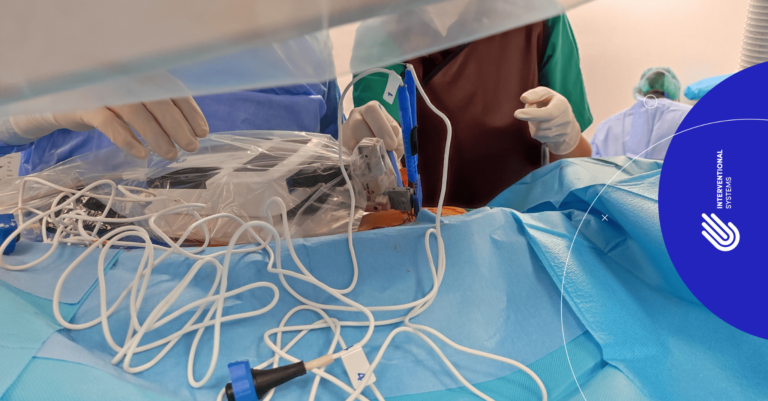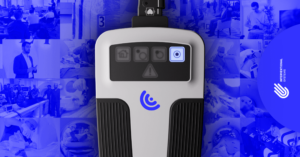Interventional Oncology (IO) provides lifesaving, minimally invasive treatments to cancer patients, including those who cannot undergo open surgery or whose tumors cannot be surgically excised due to number, size, or location. than equivalent surgical methods and lead to shorter hospital stays and faster recovery.
Still, image-guided percutaneous procedures have their own challenges: difficult needle placements, high radiation exposures, and long learning curves.
Here’s how a robotic assistance system like Micromate™ can help.
Easier, more accurate needle insertion
Placing a needle freehand is no easy feat. You need to account for moving anatomy and targets and sometimes deal with double-oblique or steep approaches while holding the instrument steadily along the planned trajectory – all while shifting your attention between your hand and a monitor.
Now repeat this process for ablative therapies like irreversible electroporation (IRE), where two or more probes must be placed parallel to create the treatment zone. Or when you need to treat bigger tumors that require the placement of multiple instruments. It is challenging, to say the least.
With Micromate™ platform, you have a helping hand to get to the target quickly without adding complexity to the workflow.
Thanks to its navigation and live-imaging capabilities, you can align the needle to the planned trajectory within seconds and achieve submillimeter accuracy, even in deep-located small tumor lesions or lesions close to critical structures. You can also make positional corrections during or after the needle insertion, which ensures a more effective procedure.
Safer, lower radiation procedures
Because you can get your needle to where it should be more easily and often at the first attempt, there is less tissue trauma and less impact on surrounding tissues, lowering the risk of bleeding or tumor seeding.
The more accurate instrument insertion also means you can avoid taking multiple control scans along the way, reducing radiation exposure both to you and your patient.
Quicker, more informed decisions
When you use a miniature robotic system, you can leverage the small footprint to quickly take intraprocedural scans without having to remove the device first or reposition it afterward.
Both the medical robot and the navigation camera are table-mounted and can fit inside the gantry of a Computed Tomography (CT) scanner. The robot is also small enough to allow the complete rotation of the Cone Beam CT (CBCT).
As a result, you are able to confirm the ablation zone, assess safety margins, and decide on any complementary treatment or confirmation biopsy during and immediately after the procedure.
More empowered IR/IO physicians
Another advantage of adopting robotic assistance devices in IO procedures is reproducibility: it has the potential to standardize clinical workflows and provide the same positive outcomes consistently, at scale.
This means less experienced IR/IO physicians can potentially achieve equivalent outcomes to those obtained by more seasoned colleagues after fewer interventions than before. You can bring the gap even closer if you choose an easy-to-use system that reduces the learning curve time.
Faster Return on Investment (ROI)
When we combine the already-known advantages of interventional oncology with more accurate targeting, safer interventions, better decisions, and more skilled physicians, the result is clear: robotic-assisted IO procedures are a cost-effective solution, especially in the long run.
Also, you can achieve a return on investment faster if you opt for a medical robotic system that can be used in multiple procedures and works with different imaging modalities. Better yet, you can purchase said system with a budget you can manage thanks to a one-of-a-kind subscription-based service: Micromate™ Subscription.
Micromate™ Subscription: bringing robotic assistance benefits to every hospital
Micromate™’s subscription-based service offers you the opportunity to benefit from all the advantages robotic assistance provides to Interventional Oncology teams for an affordable, monthly fixed fee.
This means that you can incorporate this full-fledged medical robot (CT navigation included) into your practice for a predictable cost by including it in the monthly budget you already control.
You can choose the subscription package that best suits your clinical team’s workflow according to the volume of procedures you expect to perform with Micromate™. Because procedural volume changes with time, you can also upgrade or downgrade your subscription when needed.
All subscription packages cover disposable components for each procedure, software updates, and technical assistance during the first cases — without any mandatory service agreements.
Thanks to its short learning curve, you can get to grips with the system and benefit from more accurate needle placements and reduced radiation exposures within just a few procedures. Moreover, you quickly leverage the opportunity to explore the platform and analyze the value it brings to the team.
Schedule your demo here to see how easily Micromate™ fits into your usual workflow.




